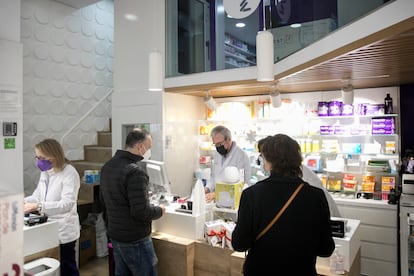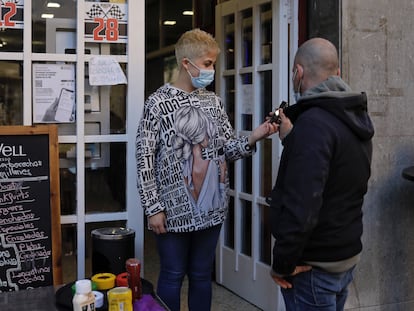Why coronavirus cases are not falling in Catalonia: Mass testing and ineffective measures
Experts believed the Spanish region was going to see the peak of the sixth wave last week, but infections continue to climb, with 215,000 reported in the past seven days

While the coronavirus incidence rate in Spain is starting to stabilize, in Catalonia, there are still no signs that it is reaching the peak of the sixth wave. Experts believe this is mainly due to the two factors: the region is carrying out a large number of tests and its coronavirus measures may not be as effective against the highly transmissible omicron variant as they were with other strains.
“We expected to reach the peak last week,” admits Jaume Sellarès, the vice president of the Official College of Physicians of Barcelona (Comb). “Perhaps the number of antigen tests being done lately has increased the number of positives.” One in four tests carried out in Spain between January 9 and 15 were done in Catalonia. In this period, the northeastern region performed 9,000 tests per 100,000 inhabitants, nearly double the national average (5,100). “This active search means that it is detecting asymptomatic cases that would surely be missed in other territories,” says Sellarès. Of the nearly 700,000 PCR and antigen tests performed by the Catalan health department, 34% came back positive, a positivity rate that is below the national average (39%), and much lower than the figure in Andalusia and Castilla La Mancha (46%).
In contrast, the seven-day incidence rate – a data point based on the number of coronavirus cases detected – is four times higher in Catalonia (2,047 per 100,000) than in Andalusia (517) and nearly double the number in Castilla La Mancha (1,215). “Comparing territories is complex because each one has its own detection and notification policies,” says Sellarès. What’s more, Catalonia allows pharmacies to directly report contagions – a system that has been able to detect minor cases that in other circumstances may not have been reported to the healthcare system. The Catalan public health department then reports the positives registered at pharmacies to the Spanish Health Ministry.
Given that the speed of the search for new cases varies from region to region, there is a mistaken view that the pandemic is hitting some territories more than others. According to the Health Ministry, Catalonia is recording 79 cases per hospital admission, while in Madrid, the figure is 43. “The virus is not acting differently according to the area,” says Carmen Cabezas, the secretary of the Catalan department of Public Health. “But it could change the clinical criteria or the health practice when it comes to the hospitalization of a patient.” Cabezas explains that the Catalan health department includes semi-critical cases in its data, “while other regions do not.”
Perhaps the number of antigen tests being done lately has increased the number of positivesJaume Sellarès, the vice president of the Official College of Physicians of Barcelona
What’s more, there continue to be discrepancies between the data from the Catalan health department and that reported by the central Health Ministry, a dynamic that has been seen throughout the pandemic and one that is particularly striking when it comes to hospitalizations for Covid-19. According to Catalonia, there are 2,705 Covid-19 patients in hospital, while the Health Ministry puts the figure at 4,275. “There is some data that comes from the socio-health sector, which in the first wave attended to people who needed to be admitted, and we suspect that the Health Ministry includes those people in the nursing home sector who have tested positive in a PCR test.”
The rise in the incidence rate in Catalonia has a common denominator: children. As part of the Catalan government’s return-to-school policy, all students have the right to an antigen test if a positive case is detected in their class. According to the Catalan health department, “this measure was not among the recommendations of the [state] guidelines, but for [Catalan] health authorities it is considered important to helping control the pandemic.”
As a result of this strategy, the number of cases detected among schoolchildren has skyrocketed. After the Christmas holidays, the incidence rate among the under-11s in Catalonia (2,485) was nearly the same as it was among children in the rest of Spain (2,317). But three and a half weeks into the school year, transmission has risen a lot more among the age group in Catalonia (6,079) than in the rest of the country (3,908). The same thing has also occurred among the 12-19 population, which has registered a similar rise. Indeed, the Catalan regional government itself says that the large number of contagions being detected at schools is due in part to the mass testing.
But despite the rise in cases, Catalonia is beginning to ease coronavirus restrictions, starting with the nighttime curfew, which will come to an end on Friday. The regional government will also debate the use of the European Union’s Digital COVID Certificate, which is currently required to enter spaces such as bars and restaurants. The effectiveness of the so-called “Covid passport” has been called into question due to the arrival of the omicron variant, which appears to have spread despite the restrictions. “With hindsight, perhaps the measures have not worked as well as they did before with other variants,” says Sellarès.

The health expert also wants to reopen discussion on the decision to reduce isolation times for positive cases, which was taken to alleviate the impact on staffing levels of so many people being off sick with Covid-19. “It’s still early, but the flu-ization [of Covid-19] will end up happening if we continue to see the rate of massive minor infections and few serious cases, and we have to be prepared to act with clear ideas,” says Sellarès.
Toni Trilla, the head of preventive medicine at Barcelona’s Clínic Hospital, agrees that a long-term view is needed on how to manage the pandemic. “At some point, we will have to live with the virus and reduce the social and economic costs of the pandemic on the government.”
Catalonia has reported 215,000 new coronavirus cases in a week, up 24% with respect to last week. While there is a slowdown in the rise, there is still no sign of the peak of the sixth wave. Tomàs Pumarola, the head of microbiology at the Vall d’Hebron Hospital, believes this point will be reached “in one or two weeks.”
Meanwhile in Spain, the 14-day incidence rate has fallen for the third day in a row. According to the Health Ministry report, the data point dropped seven points on Thursday to 3,279 cases per 100,000 inhabitants. A total of 157,447 new cases were reported, and 162 deaths were added to the official toll, which now stands at 91,599. Pressure on hospitals also eased on Thursday, with 18,934 Covid-19 patients in wards, a drop of 66 since Wednesday, and 2,204 in intensive care units, down from 2,230.
Tu suscripción se está usando en otro dispositivo
¿Quieres añadir otro usuario a tu suscripción?
Si continúas leyendo en este dispositivo, no se podrá leer en el otro.
FlechaTu suscripción se está usando en otro dispositivo y solo puedes acceder a EL PAÍS desde un dispositivo a la vez.
Si quieres compartir tu cuenta, cambia tu suscripción a la modalidad Premium, así podrás añadir otro usuario. Cada uno accederá con su propia cuenta de email, lo que os permitirá personalizar vuestra experiencia en EL PAÍS.
¿Tienes una suscripción de empresa? Accede aquí para contratar más cuentas.
En el caso de no saber quién está usando tu cuenta, te recomendamos cambiar tu contraseña aquí.
Si decides continuar compartiendo tu cuenta, este mensaje se mostrará en tu dispositivo y en el de la otra persona que está usando tu cuenta de forma indefinida, afectando a tu experiencia de lectura. Puedes consultar aquí los términos y condiciones de la suscripción digital.











































